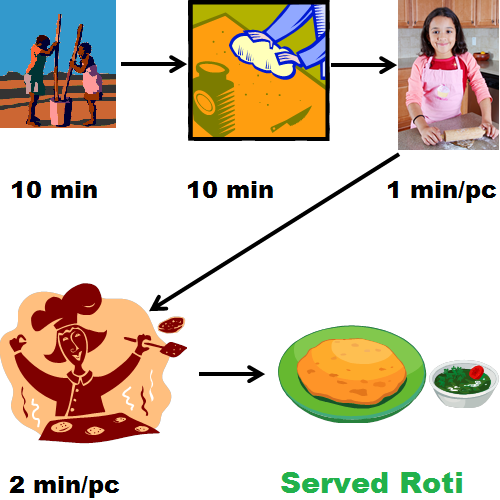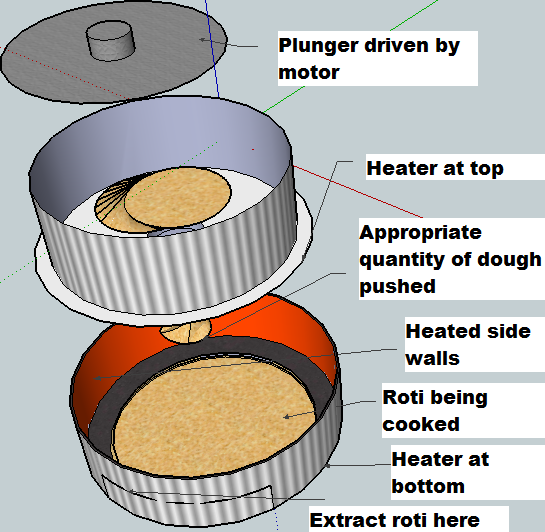A North Indian family meal is incomplete without Roti/fulka/chapatti (bread). A family eats roti at least in one meal in a day. There are some deviations – roti eaten both times or roti not eaten in any meals in a day, however, the average would still be the same. Even though roti is so popular, devices to make roti are still in their infancy. You may start your venture in this vacuum.
Background
There are multiple factors that when controlled in tandem, determines the quality of a roti. No parameter is less important.
- Grinding wheat to make wheat flour
- Quality of wheat. Many a times, families mix soy, chick peas or something else when wheat is floured.
- How finely wheat is crushed.
- Kneading of floor
- The ratio of wheat to water.
- How well dough is squeezed, punched, shaken, rubbed, pounded
- What is mixed in floor while kneading the floor? Sometimes salt, pepper, last night pulses are mixed while kneading flour.
- Freshness of kneaded floor
- Baking of roti
- Make a thin layer of kneaded floor so that it can be baked
- How gently raw roti is placed on the hot plate (tawa)
- Temperature of hot plate
- The timing of turning over half-baked roti
- How long roti stays on hot plate
- How much pressure is applied on roti while it is being baked
- Storage and serving of roti
- Roti can be served just when it has been baked
- Roti can be stored in a casserole so that the whole family can eat meal together
Roti served fresh just when it has been baked, tastes the best. However, that deprives a chance for a family to eat the meal together.

Of all the steps for serving a fresh roti, baking of all the roti and then serving just when it has been baked is the step that hinders family eating together. Moreover, baking each roti takes not less than 2 minute. If a family needs to bake 10 Roti then it would take 20 minutes by when freshness of roti is lost. Moreover, the lady of the house needs to stand next to hot plate for at least 20 minutes.
That’s the reason, market is flooded with roti makers. The roti makers claims to make a nice roti in the least amount of time and can be made on the dinner table itself. However, the claims are taller than reality.
- Roti maker works after flour has been rolled in the shape of roti and placed on roti maker. Someone will still need to roll the flour.
- Baking roti on roti maker takes longer time than baking on hot plate or directly on the stove.
- Contrary to pictures of roti getting full and fluffy in roti maker, the flour just sticks to roti maker. Roti maker doesn’t work well.
The problems that need to be addressed are as follows:
- It is not just baking of roti but also rolling of each roti that is time consuming.
- Quality of roti made by roti maker is not good.
Proposal
- Automate preparation of roti making by making a device that looks like a food processor. It should really be a size of food processor.
- It should have storage for dough or flowing mixture of wheat and water. The storage can be small, for may be, one time food.
- It should pour pre-determined quantity of dough or paste on hot plate. It should be able to control temperature of hot plate.
- It should turn around roti or have two parallel hot plates between which roti bakes or blow hot air around the roti.
- It should continue to serve roti until family members are eating. There may be a button or voice recognition to start cooking roti or stop cooking roti.

What may be challenges?
- You will need to measure all the factors to make fluffy, swollen, warn, steaming roti. While you learn the art of roti making, you will need to experiment whether traditionally rolled dough is the best way to make roti or pouring water and flour mixture too can work.
- Roti making may not be easy because that may be the reason that none of the roti makers available in market seems to be giving the desired result. However, roti making is in Indian culture and it is a routine activity. One gets to see this activity so often, interview experts, learn best practices, practice on your own and learn this art.
- On technical side, there are roti makers available. You will need to learn how those roti-makers work (and why they don’t work). Pick the best practices (material of hot plate, thermostat etc.) from those systems but concentrate on your end result. End result can be warm and heart filling.
Will you start this venture? If yes, go ahead and share your story. If no then stay tuned for next venture idea.